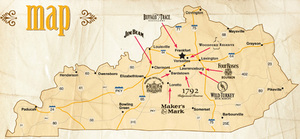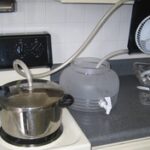In the early colonial history of America, a Baptist minister named Elijah Craig is believed by many to have been the first true distiller of bourbon whiskey in Georgetown Kentucky. Mr. Craig then began producing whiskey from a corn base, and the roots of bourbon whiskey began. Elijah Craig’s bourbon still is believed by many to have possibly been the first whiskey still in the area.
Soon customers christened his product as “Bourbon County Whiskey” from the county of its origin. This is one theory which is stated by: Alexis Lichines, in the encyclopedia of Gastronomy by Andre L. Simon, and also Robert A. Powell, author of a history text which was used in Kentucky schooling at the time. Powell states in his text that “the same name was later given to a pioneer product, Kentucky’s famous ‘Bourbon’ Whiskey.”
To trace the roots of Kentucky’s bourbon back to its origin, you have to first look at the work of Richard Collins’ “History of Kentucky” which was published in 1874. Collins does not directly identify Craig as the first distiller of bourbon, but states that “the first bourbon whiskey was made in 1789 at Georgetown, at the fulling Mill at the Royal spring.” Although Craig was a distiller, and operated a fulling mill at the Royal spring, he was not mentioned in Collins work. At that time in Kentucky history counties were changed and boundaries we added or subtracted but Bourbon County remained the same.
Other stories tell of Fort Harrod as being the first permanent distiller, which is now Harrodsburg Kentucky, just a short piece down the road from Louisville. Fort Harrod was first established in 1774, a few years before Craig’s distilling. How Louisville came into the bourbon business concerns the business of the mighty Ohio River and its growing industry and trade at the time.
Kentucky was admitted as a state into the union in 1792, and now a new legislation was carving up what had been nine counties into many more. By 1800 there were now 43 counties in Kentucky, and bourbon was spreading like wild fire throughout the counties.
In 1785 it’s been stated that a dozen if not a hundred farmers were making whiskey through the region. In those days with very few roads and a low market for the farmer’s crops, the practical way to sell their crops was to distill it into whiskey. This whiskey was then loaded into flat bottom boats along with hemp and shipped down the Ohio River to New Orleans for sale.
One of most important river ports at the time in Kentucky was Maysville, which at the time was referred to as Limestone. This port in Limestone was in use when “two Navel officers or collectors” were sent to the “Falls of the Ohio” which is now Louisville. These collectors were to watch and supervise the traffic on the Ohio River and collect tolls. And now, whiskey was a growing cash crop to be involved in, and Louisville just happened to be sitting in the right spot, at the right time.
This area of Kentucky soon became known as “Old Bourbon.” People soon believed that OId Bourbon was the best, so business began to thrive in all of the surrounding counties. Soon bourbon was being produced elsewhere and labeled as Old Bourbon, no matter where it was distilled. Eventually around 1840 the name simply became bourbon.
Louisville was considered the mouth of Limestone along with the Navel supervisors at the falls of the Ohio (Louisville) where all traffic was patrolled. Now bourbon whiskey was growing in leaps and bounds in Kentucky, and Louisville soon joined into the act.
Many distillers in Kentucky have played a big part in the history of bourbon whiskey, along with the abundance of: white oak trees, limestone water, and fields of corn. These ingredients along with the hot summers and cold winter nights are the perfect combination for distilling bourbon whiskey.
Jim Beam distilleries in Clermont Kentucky, has been brewing bourbon for seven generations; over two hundred years. Wild turkey which is brewed in Lawrenceburg Kentucky, has twelve distilleries which provides the world with 90 to 95% of its bourbon whiskey. Makers Mark which is brewed in Lorreto Kentucky, is brewed from “iron free” spring lake water. Bardstown Kentucky is considered the “bourbon capitol of the world” with its many distilleries.
Taking a tour of Kentucky’s bourbon trial which treks along some of the most beautiful back roads of Kentucky would take a little longer than you might expect. Louisville and Kentucky’s history goes back to the very roots of bourbon whiskey. If your ancestors were originally from Kentucky, there’s a chance that they were distilling bourbon whiskey at its very beginning.
Source of information: www.straightbourbon.com/articles/ccname.html-



